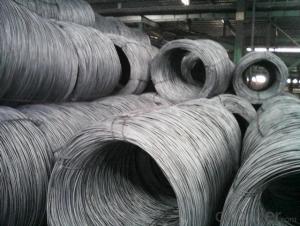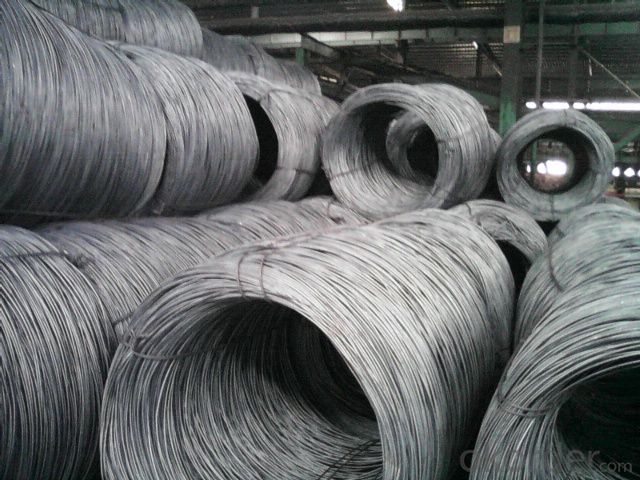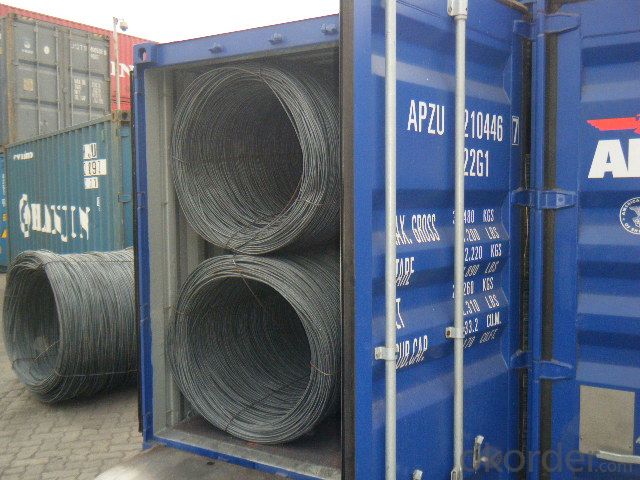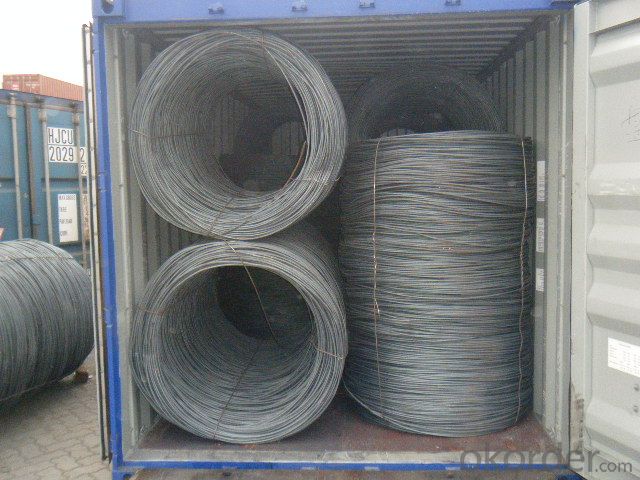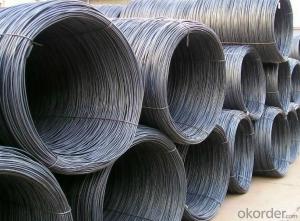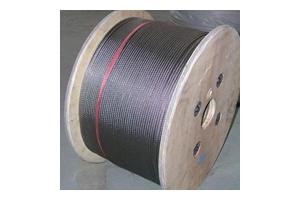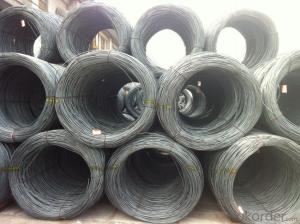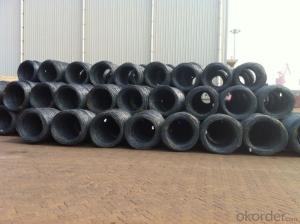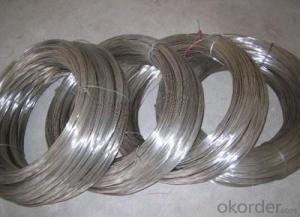Carbon Steel Wire Rod with High Quality for Construction
- Loading Port:
- China main port
- Payment Terms:
- TT or LC
- Min Order Qty:
- 20 m.t.
- Supply Capability:
- 10000 m.t./month
OKorder Service Pledge
OKorder Financial Service
You Might Also Like
Specifications of Carbon Steel Wire Rod with High Quality for Construction:
Steel Grade: Q195/235, SAE1006-1018B Standard: ASTM, GB
Diameter: 5.5mm, 6.5mm, 7mm,8mm,9mm,10mm,12mm,14mm
Diameter tolerance: ±0.3mm Type: in coil, coil weight around 2MT
Technique: Hot Rolled Place of Origin: China Mainland
Surface: round, no twisted, light and smooth Brand Name: HSKY
Chemical Composition: (Please kindly find our chemistry of our material based on Q195、Q235A and Q235B as below for your information)
Usage and Applications of Carbon Steel Wire Rod with High Quality for Construction:
After hot-rolled the products shaped into coil and delivery as finished product, including round, square, rectangular, hexagonal and so on. Since most of the products are round, it is generally called wire rod. Carbon steel wire rod is widely used in construction and manufacturing. Carbon steel wire rod is mainly used for reinforcement of reinforced concrete and welded structure or reprocessed (roberts , nail, etc.) materials, especially used to produce wire drawing, welding electrode, nails, spring, electronic, precise machinery parts and so on.
Packaging & Delivery of Carbon Steel Wire Rod with High Quality for Construction:
Packaging Detail: products are packed in coil, each coil weight around 2 MT, and then shipped by container or bulk vessel
Delivery Detail: within 45 days after received deposit or LC.
Label: to be specified by customer, generally, each bundle has 1-2 labels
Trade terms: FOB, CFR, CIF
FAQ:
Q1: How soon can we receive the product after purchase?
A1: Within three days of placing an order, we will begin production. The specific shipping date is dependent upon international and government factors, but is typically 7 to 10 workdays.
Q2: What makes stainless steel stainless?
A2: Stainless steel must contain at least 10.5 % chromium. It is this element that reacts with the oxygen in the air to form a complex chrome-oxide surface layer that is invisible but strong enough to prevent further oxygen from "staining" (rusting) the surface. Higher levels of chromium and the addition of other alloying elements such as nickel and molybdenum enhance this surface layer and improve the corrosion resistance of the stainless material.
Q3: Can stainless steel rust?
A3: Stainless does not "rust" as you think of regular steel rusting with a red oxide on the surface that flakes off. If you see red rust it is probably due to some iron particles that have contaminated the surface of the stainless steel and it is these iron particles that are rusting. Look at the source of the rusting and see if you can remove it from the surface.
Images:
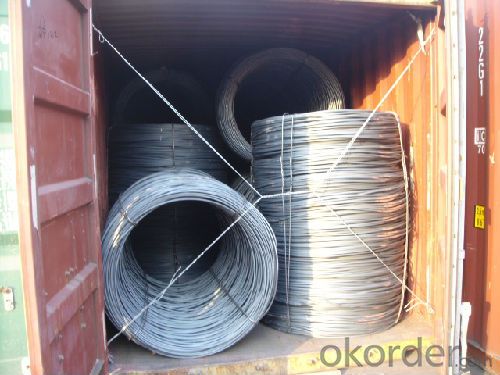

- Q: What are the common applications of alloy steel wire rod?
- Alloy steel wire rod has a wide range of applications due to its unique properties and characteristics. Some of the common applications of alloy steel wire rod include: 1. Automotive industry: Alloy steel wire rods are extensively used in the automotive industry for the production of various components such as springs, suspension systems, wheel rims, and engine parts. The high strength and durability of alloy steel wire rod make it suitable for withstanding the demanding conditions and loads experienced by these components. 2. Construction industry: Alloy steel wire rods are also widely used in the construction industry. They are utilized in the manufacturing of reinforcing bars (rebars) which are essential for reinforcing concrete structures such as bridges, buildings, and highways. The high tensile strength and corrosion resistance of alloy steel wire rod ensure the longevity and structural integrity of these constructions. 3. Manufacturing industry: Alloy steel wire rods find applications in various manufacturing processes such as welding, machining, and fabrication. They are commonly used in the production of fasteners, wire mesh, wire ropes, and springs. The unique properties of alloy steel, such as high tensile strength, good formability, and resistance to wear and fatigue, make it an ideal choice for these applications. 4. Aerospace industry: Alloy steel wire rods are employed in the aerospace industry for the production of components and parts that require high strength, excellent fatigue resistance, and resistance to extreme temperatures. These include aircraft landing gear, engine components, and structural parts. The superior mechanical properties of alloy steel wire rod make it suitable for withstanding the demanding conditions encountered in aerospace applications. 5. Energy industry: Alloy steel wire rods are used in the energy industry for various applications. They are utilized in the manufacturing of power transmission cables, electrical conductors, and wire mesh screens. The high electrical conductivity and corrosion resistance of alloy steel wire rod make it an ideal choice for these energy-related applications. In summary, alloy steel wire rod is commonly used in the automotive, construction, manufacturing, aerospace, and energy industries due to its high strength, durability, formability, and resistance to wear, corrosion, and fatigue. Its versatility and unique properties make it an essential material for a wide range of applications.
- Q: How is steel wire rod used in the production of wire for automotive seat springs?
- The production of wire for automotive seat springs relies heavily on steel wire rod, which is an indispensable component. To enhance its mechanical properties, such as strength, durability, and flexibility, the wire rod undergoes a series of steps involving heating and cooling. Once the steel wire rod has been processed, it is drawn down further to achieve the desired diameter for the seat springs. This drawing process entails pulling the wire rod through a set of dies, simultaneously reducing its diameter and increasing its length. This step is critical to attaining the desired mechanical properties and ensuring that the wire can withstand the stress and pressure experienced by automotive seat springs. Once the wire has reached the desired diameter, it is then shaped into the specific coil form required for the seat springs. Through the use of specialized machinery, the wire is coiled and molded into the desired shape, ensuring that it meets the design requirements and provides the necessary support and comfort for automotive seats. The use of steel wire rod in wire production for automotive seat springs is crucial due to its exceptional tensile strength and resistance to fatigue and corrosion. These properties enable the wire to withstand the constant pressure and movement experienced by automotive seat springs, resulting in long-lasting performance and durability. Additionally, steel wire rod offers the advantages of being cost-effective and readily available, making it the preferred choice for automotive manufacturers. Its versatility allows for customization, enabling the production of wire with specific characteristics tailored to meet the requirements of different types of seat springs. In conclusion, steel wire rod plays a vital role in the production of wire for automotive seat springs. Through various processing steps, the wire rod is transformed into high-quality wire that possesses the necessary strength, durability, and flexibility to support and provide comfort to automotive seats.
- Q: What are the standard tensile strength requirements for steel wire rod?
- The standard tensile strength requirements for steel wire rod vary depending on the specific grade and application. However, commonly used steel wire rods typically have a tensile strength range of 400 to 1000 megapascals (MPa).
- Q: How is steel wire rod used in the manufacturing of conveyor belts?
- Steel wire rod is used in the manufacturing of conveyor belts as it provides strength and durability. The wire rod is used to create the core of the conveyor belt, providing stability and support. It is also used to reinforce the belt, ensuring it can withstand heavy loads and high tension. Additionally, the steel wire rod is coated with various materials to enhance its corrosion resistance and improve the belt's overall performance.
- Q: What are the safety considerations for using steel wire rod in construction?
- Some safety considerations for using steel wire rod in construction include ensuring proper handling and storage to prevent injuries, using appropriate personal protective equipment such as gloves and safety glasses, conducting regular inspections to check for any defects or damage in the wire rod, and following proper installation techniques to ensure structural integrity and prevent accidents.
- Q: What is steel wire rod?
- Steel wire rod is a long, cylindrical semi-finished metal product that is produced through a series of rolling processes. It is made from high-quality steel and has a round cross-section. Steel wire rod is used as a raw material in various industries, such as construction, automotive, and manufacturing, where it is further processed into different forms of wire products, such as nails, bolts, springs, and wire mesh.
- Q: How is steel wire rod used in the production of fasteners?
- Steel wire rod is used in the production of fasteners as it serves as the primary raw material for manufacturing various types of fasteners, such as bolts, screws, nails, and rivets. The wire rod is first drawn through a series of dies to reduce its diameter and increase its length, resulting in a wire with the desired dimensions. This wire is then cut into specific lengths, threaded if necessary, and further processed to form the required shape and head of the fasteners. The high strength and durability of steel wire rod make it an ideal material for fasteners, ensuring the reliability and performance of the final product.
- Q: How is steel wire rod used in the manufacturing of wire rope hooks?
- Steel wire rod is used in the manufacturing of wire rope hooks as it serves as the raw material for creating the sturdy and durable hooks. The steel wire rod is first processed and shaped into the desired hook design, ensuring strength and resilience to withstand heavy loads and stresses. It undergoes various manufacturing processes such as cutting, bending, and heat treatment to achieve the desired properties and shape. Once the steel wire rod is transformed into wire rope hooks, it can be securely attached to wire ropes, enabling safe and efficient lifting and securing of heavy objects in various industries.
- Q: How is steel wire rod used in the manufacturing of wire strands for suspension bridges?
- Steel wire rod is used in the manufacturing of wire strands for suspension bridges as it serves as the primary material for creating the strong and durable cables required to support the bridge. The steel wire rod is typically twisted together to form wire strands, which are then bundled together to create the main suspension cables. These cables are crucial for withstanding the immense tension and weight placed on the bridge, ensuring its structural integrity and providing safe passage for vehicles and pedestrians.
- Q: How is steel wire rod used in the manufacturing of wire forms for security fencing?
- Steel wire rod is used in the manufacturing of wire forms for security fencing by being processed through various stages such as drawing, annealing, and coating to obtain the desired strength, flexibility, and corrosion resistance. This rod is then shaped and welded into different wire forms, such as mesh panels or barbed wire, which are essential components of security fencing.
Send your message to us
Carbon Steel Wire Rod with High Quality for Construction
- Loading Port:
- China main port
- Payment Terms:
- TT or LC
- Min Order Qty:
- 20 m.t.
- Supply Capability:
- 10000 m.t./month
OKorder Service Pledge
OKorder Financial Service
Similar products
Hot products
Hot Searches
Related keywords
